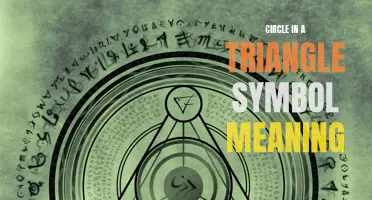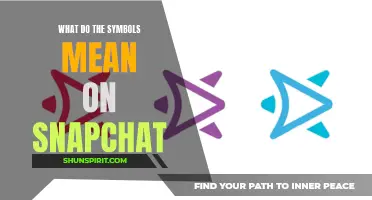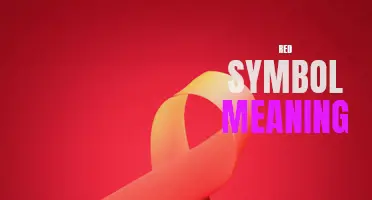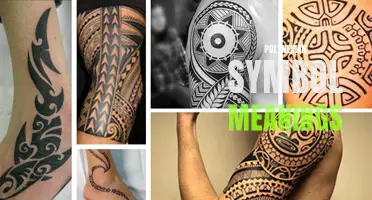
Druidic symbols and their intriguing meanings have captivated the imagination of people throughout history. Rooted in ancient Celtic culture, these symbolic representations reflect the deep spiritual connection that Druids had with nature and the divine. From the mystical trinity knot symbolizing endless cycles of life to the powerful oak tree symbolizing strength and wisdom, each druidic symbol carries layers of enigmatic significance waiting to be unraveled. Join me in this journey as we explore the profound meanings behind these timeless symbols and unlock the ancient wisdom they hold.
What You'll Learn
- What is the history and origin of druidic symbols and their meanings?
- Can you provide a comprehensive explanation of the most common druidic symbols and their associated meanings?
- Are there any specific rituals or practices associated with the use of druidic symbols?
- How have modern interpretations of druidic symbols and meanings evolved compared to ancient interpretations?
- Are there any specific books or resources you would recommend for further study on druidic symbols and meanings?

What is the history and origin of druidic symbols and their meanings?
The history and origin of druidic symbols and their meanings can be traced back to the ancient Celtic civilization. The Celts inhabited a large portion of Europe and the British Isles from around 800 BCE to 400 CE, with their culture flourishing during the Iron Age.
The druids were the religious leaders and intellectuals of the Celtic society, and they played a crucial role in shaping their religious and spiritual beliefs. They were highly respected and possessed a deep understanding of nature, the universe, and the connections between them.
Druidic symbols were an essential part of their religious practices and rituals. These symbols were often depicted in various forms such as rock carvings, engraved on stone monuments, and seen in ornamentation on jewelry and weapons. The meanings behind these symbols were considered sacred and held great significance for the druids and the Celtic people.
One of the most well-known druidic symbols is the triskelion, also known as the triple spiral. It consists of three interlocking spirals that form a continuous shape. The triskelion symbolizes the journey of life, death, and rebirth, as well as the interconnectedness of the past, present, and future. It is also associated with the cycle of the seasons and the three realms of land, sea, and sky.
Another important druidic symbol is the tree of life. In Celtic mythology, trees were considered sacred and held a deep spiritual significance. The tree of life represents the connection between the physical and spiritual realms, and it symbolizes growth, strength, and wisdom. It also signifies the cycles of nature and the eternal cycle of life, death, and rebirth.
The Celtic cross is another prominent druidic symbol. It combines a cross, representing Christianity, with a circle, representing the sun, and is often associated with the fusion of Celtic and Christian beliefs. The Celtic cross represents the balance between the spiritual and physical worlds and serves as a symbol of protection and divine guidance.
Other druidic symbols include the spiral, which represents growth and transformation, and the triquetra, which symbolizes the trinity and the interconnectedness of mind, body, and spirit. These symbols were often used in divination, meditation, and other spiritual practices.
The meanings behind druidic symbols are often multifaceted and can vary depending on interpretation and context. They reflect the deep connection between the Celts and nature, as well as their understanding of the cyclical nature of life and the universe.
Today, druidic symbols continue to be recognized and utilized by modern practitioners of Druidry and Celtic spirituality. They serve as a reminder of the ancient wisdom and spiritual practices of the druids and the enduring power of nature. These symbols are not only a source of inspiration and guidance, but also a way to connect with the rich cultural heritage of the Celtic people.
Decoding the Symbolic Meaning Behind The Gift on Netflix
You may want to see also

Can you provide a comprehensive explanation of the most common druidic symbols and their associated meanings?
Druidism is an ancient spiritual practice that originated in Celtic cultures. It is rooted in a deep connection with nature and the worship of various natural elements. Druids, the spiritual leaders and practitioners of this belief system, often use symbols to communicate their reverence for nature and to convey spiritual meanings. Here, we explore some of the most common druidic symbols and their associated meanings.
- Triquetra: Also known as the Celtic Trinity Knot, the triquetra symbolizes the interconnectedness of three separate entities or forces. It represents the triple aspect of existence found in many Celtic beliefs, such as the three realms of earth, sea, and sky, or the three stages of life: birth, life, and death.
- Awen: The Awen symbol consists of three rays, representing the triple nature of druidry: the harmony of mind, body, and spirit. It is often associated with inspiration, creativity, and the flow of divine wisdom. The Awen symbol is highly revered by modern Druids and is seen as a source of spiritual enlightenment.
- Oak Tree: The oak tree holds great significance in druidic traditions. It represents strength, longevity, and wisdom. Druids believe that the oak tree is a conduit for divinity and acts as a connection between the earthly and spiritual realms. The oak tree is often seen as a symbol of protection and stability.
- Spiral: The spiral is a common symbol used in many ancient cultures, including the Celts. For druids, it represents the cyclical nature of life, death, and rebirth. It symbolizes continuous growth, evolution, and the eternal cycle of the universe. The spiral is also associated with personal transformation and spiritual journey.
- Green Man: The Green Man is a symbol of vitality, fertility, and the life force present in nature. It is often depicted as a face surrounded by foliage or as a figure made entirely of leaves, branches, and vines. The Green Man represents the spirit of nature and the interconnectedness of all living things.
- Triskele: The triskele is a three-legged spiral symbol that represents the threefold nature of existence. It is often associated with the cycles of life, death, and rebirth. The triskele also represents the power of transformation and the balance between past, present, and future.
- Bardic Harp: The Bardic Harp represents the art of storytelling, music, and poetic expression. Bards, the storytellers and poets of ancient Celtic culture, held a sacred role in druidic traditions. The Bardic Harp symbolizes the power of words and the ability to connect with the divine through storytelling and music.
- Cauldron: The cauldron is a symbol of transformation, rebirth, and abundance. It represents the transformative power of the divine, where old energies are destroyed, and new energies are created. The cauldron is associated with healing, inspiration, and mystical knowledge.
These are just a few of the many symbols used in druidic traditions. Each symbol carries its own unique meaning and significance, and they are often combined in various ways to create intricate and personalized spiritual representations. These symbols serve as a reminder of the druidic belief in the sacredness of nature and the interconnectedness of all things. They act as a bridge between the physical and spiritual realms, guiding practitioners on their spiritual journeys and enhancing their connection with the natural world.
Decoding the Nissan Murano Dashboard Symbols: Understanding the Meanings Behind the Warning Lights
You may want to see also

Are there any specific rituals or practices associated with the use of druidic symbols?
Druidic symbols are an integral part of the spiritual and magical practices of the Druids, an ancient group of Celtic priests and scholars with a deep connection to nature and the divine. These symbols hold great significance and are often used in rituals and ceremonies to invoke spiritual energies and communicate with the forces of nature.
The use of Druidic symbols in rituals and practices is steeped in tradition and symbolism. Each symbol represents a unique aspect of nature, spirituality, or Celtic mythology. Understanding and harnessing the power of these symbols is essential for Druids to connect with the natural world and channel their spiritual energy.
One of the most significant rituals involving Druidic symbols is the celebration of the eight seasonal festivals, known as the Wheel of the Year. Each festival is associated with a specific symbol that represents the changing seasons and the cyclical nature of life. For example, the symbol of the oak tree represents the festival of Alban Hefin (Summer Solstice) and is associated with strength, endurance, and the height of summer.
During these festivals, Druids gather in sacred groves or natural spaces to perform ceremonies that honor the natural cycles of life. They often create altars adorned with Druidic symbols and use them as focal points for their rituals. The symbols act as gateways through which they connect with the spiritual energies and deities associated with each festival.
Another common practice involving Druidic symbols is divination. Druids believe that these symbols can reveal hidden truths and provide guidance for decision-making or spiritual insight. They use various methods like casting runes or drawing cards with Druidic symbols on them to interpret messages from the divine or the natural world.
In addition to rituals and divination, Druidic symbols are also used for meditation and personal growth. Druids often incorporate symbols into their daily meditation practices, visualizing them or drawing them to connect with specific energies or qualities. They may also wear or carry jewelry or talismans adorned with these symbols as a way to invoke their power and protection.
It's important to note that the specific rituals and practices associated with Druidic symbols may vary depending on the individual or the Druidic tradition they follow. While some Druids adhere closely to ancient practices and rituals, others may adapt or develop new practices that align with their personal beliefs and spiritual path.
In conclusion, Druidic symbols play a vital role in the spiritual and magical practices of the Druids. They are used in rituals, divination, meditation, and personal growth to connect with nature and the divine, and to gain insight and guidance. These symbols are deeply rooted in tradition and hold profound significance for those who follow the path of Druidry.
The Symbolic Meanings of Sanskrit Symbols: Unlocking the Ancient Wisdom
You may want to see also

How have modern interpretations of druidic symbols and meanings evolved compared to ancient interpretations?
Ancient Druids were members of a religious order in ancient Celtic societies. They were known for their deep connection with nature and their spiritual beliefs. The symbols and meanings they used in their practices have been handed down through generations, but their interpretations have evolved over time. Modern interpretations of druidic symbols and meanings reflect the changes in society, culture, and understanding of the world.
One of the most well-known symbols associated with the Druids is the Celtic Knot. This intricate interlacing pattern is believed to represent the interconnectedness of all things and the eternal cycle of life. In ancient times, the Celtic Knot was often used as a decorative motif, but its deeper meaning was often understood only by the Druids themselves. In modern times, the Celtic Knot has become a popular symbol of Celtic pride and heritage, and its meaning has been expanded to represent love, loyalty, and eternity.
Another important symbol in Druidic tradition is the Tree of Life. The ancient Druids believed that the tree was a sacred symbol of growth, wisdom, and spiritual connection. Different trees held different meanings, and the Druids would often perform rituals and ceremonies in sacred groves. Today, the Tree of Life is still seen as a symbol of wisdom and connection to nature, but its meaning has been expanded to represent the interconnectedness of all life and the balance between earth, sky, and underworld.
The Druids also held a deep reverence for the sun, moon, and stars. They believed that these celestial bodies held great spiritual power and played a significant role in shaping the world. In ancient times, the Druids would observe the movements of the stars and use them to predict and understand natural events. Today, modern interpretations of druidic symbols related to celestial bodies often focus on their spiritual significance and their impact on personal growth and transformation.
In addition to symbols, the meanings associated with certain plants and animals have also evolved over time. For example, the ancient Druids believed that mistletoe was a symbol of healing and protection. It was often used in rituals and ceremonies to ward off evil spirits and bring about good fortune. In modern times, mistletoe is still associated with the holiday season and is seen as a symbol of love and romance.
Overall, modern interpretations of druidic symbols and meanings have evolved compared to ancient interpretations due to societal changes, cultural shifts, and advancements in knowledge and understanding. While the core principles and beliefs of the Druidic tradition remain, their symbols and meanings have been adapted and expanded to resonate with the modern world. Today, druidic symbols and meanings continue to inspire and empower individuals on their spiritual journeys, connecting them to nature and the wisdom of the ancients.
Decoding the Symbolic Meaning Behind Stranger Things
You may want to see also

Are there any specific books or resources you would recommend for further study on druidic symbols and meanings?
If you're interested in delving deeper into the world of druidic symbols and their meanings, there are several books and resources that can provide you with a wealth of knowledge. Whether you're a curious beginner or a seasoned practitioner, these resources will help you uncover the hidden wisdom behind these ancient symbols.
- "The Druidry Handbook: Spiritual Practice Rooted in the Living Earth" by John Michael Greer: This comprehensive guide explores the core beliefs and practices of modern druidry, including the study of druidic symbols. It provides a solid foundation for understanding the deeper meanings behind these symbols and how they relate to the natural world.
- "The Druid Animal Oracle: Working with the Sacred Animals of the Druid Tradition" by Philip and Stephanie Carr-Gomm: This book focuses specifically on the animal symbols used in druidic symbolism. It offers interpretations and guidance for working with these symbols to gain insight into the natural world and connect with animal energies.
- "Celtic Lore & Spellcraft of the Dark Goddess: Invoking the Morrigan" by Stephanie Woodfield: This book explores the mythology and symbolism of the Morrigan, a powerful Celtic goddess associated with warfare and transformation. It delves into the symbolism of the raven, one of the key symbols associated with the Morrigan, and provides rituals and meditation practices to connect with her energy.
- "The Druid Magic Handbook: Ritual Magic Rooted in the Living Earth" by John Michael Greer: This book explores the magical practices of the Druid tradition and how they can be applied in modern times. It covers a wide range of topics, including the use of symbols and rituals to harness natural energies and work with the forces of nature.
In addition to books, there are also online resources that can help you deepen your understanding of druidic symbols. Websites such as "The Order of Bards, Ovates, and Druids" and "A Druid Fellowship" offer articles, discussion forums, and additional resources on druidic symbolism and meanings.
When studying druidic symbols, it's important to approach the subject with an open and curious mind. Symbols can have multiple interpretations and may hold personal significance for individuals. As you explore these resources, allow your intuition to guide you and develop your own understanding of the symbols based on your experiences and insights.
The Incredible Cultural Significance of Latvian Symbols and Their Meanings
You may want to see also
Frequently asked questions
The Celtic Cross is a powerful symbol in Druidic symbolism. It represents the intersection point between the material and spiritual worlds and embodies the interconnectedness of all things. The circle in the center of the cross symbolizes eternity and the never-ending cycle of life and death. It is a sacred symbol that is often used in rituals and ceremonies to connect with the divine and to seek wisdom and guidance from the ancestors.
The Triskele is a symbol that consists of three interlocking spirals. It is a complex symbol with multiple meanings in Druidic symbolism. Some interpret it as representing the three realms of existence – the physical, the mental, and the spiritual. It is also associated with the three elements of nature – earth, sky, and sea. Additionally, the Triskele is seen as a symbol of forward movement, personal growth, and continuous evolution.
The Tree of Life is a central symbol in Druidic symbolism, representing the interconnectedness of all life and the cycle of birth, growth, death, and rebirth. It is often depicted as a large tree with roots reaching into the earth and branches extending into the sky, symbolizing the connection between the physical and spiritual realms. The Tree of Life is a symbol of wisdom, strength, and harmony with nature, and it is commonly used in meditation and spiritual practices to deepen one's connection to the natural world.
The Ogham alphabet is an ancient Celtic writing system that is often associated with Druidic symbolism. Each letter in the Ogham alphabet is represented by a series of vertical or diagonal lines carved into wood or stone. It is believed that the Ogham alphabet was not only used for written communication but also had a deeper symbolic meaning. Some interpret the Ogham alphabet as a sacred language or a means of divination, while others see it as a way to tap into the wisdom and knowledge of the ancient Druids. Overall, the Ogham alphabet is a powerful tool in Druidic symbolism for conveying messages and connecting with the ancient Celtic traditions.







